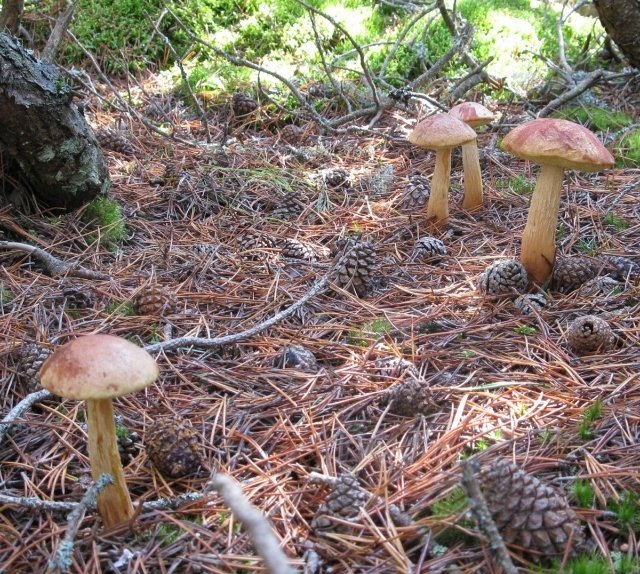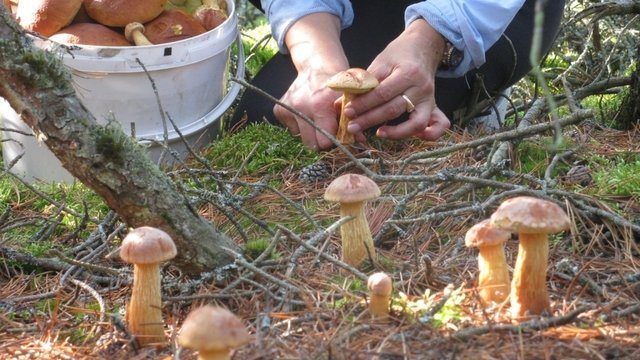Golden Boletus (Aureoboletus projectellus)
- Division: Basidiomycota (Basidiomycetes)
- Subdivision: Agaricomycotina (Agaricomycetes)
- Class: Agaricomycetes (Agaricomycetes)
- Subclass: Agaricomycetidae (Agaricomycetes)
- Order: Boletales (Boletales)
- Family: Boletaceae (Boletaceae)
- Genus: Aureoboletus (Aureoboletus)
- Type: Aureoboletus projectellus (Golden Boletus)
:
- A small projectile
- Ceriomyces projectellus
- Boletellus Murrill
- Heather boletus

Previously considered a widespread American species, from Canada to Mexico. However, in recent decades it has been confidently conquering Europe.
In Lithuania they are called balsevičiukas (balsevičiukai). The name comes from the name of the forester Balsevicius, who was the first in Lithuania to find this mushroom and taste it. The mushroom turned out to be tasty and became famous in the country. It is believed that these mushrooms appeared on the Curonian Spit about 35-40 years ago.
head: 3-12 centimeters in diameter (some sources give up to 20), convex, sometimes becoming broadly convex or almost flat with age. Dry, finely velvety or smooth, often cracking with age. The color is reddish-brown to purplish-brown or brown, with a sterile edge – an overhanging skin, “projecting” = “overhang, hang down, protrude”, this feature gave the name to the species.
Hymenophore: tubular (porous). Often pressed around the leg. Yellow to olive yellow. Does not change or almost does not change color when pressed, if it changes, it is not blue, but yellow. The pores are round, large – 1-2 mm in diameter in adult mushrooms, tubules up to 2,5 cm deep.
Leg: 7-15, up to 24 centimeters high and 1-2 cm thick. May be slightly tapered at the top. Dense, elastic. Light, yellowish, yellow intensifies with age and reddish, brown shades appear, becoming brownish-yellowish or reddish, close to the color of the cap. The main feature of the leg of the Golden Boletus is a very characteristic ribbed, mesh pattern, with well-defined longitudinal lines. The pattern is clearer in the upper half of the leg. At the base of the stem, white mycelium is usually clearly visible. The surface of the stem is dry, sticky in very young mushrooms or in humid weather.

spore powder: olive brown.
Споры: 18-33 x 7,5-12 microns, smooth, flowing. Reaction: gold in CON.
Pulp: dense. Light, whitish-pinkish or whitish-yellowish, does not change color when cut and broken or changes very slowly, becoming brownish, brownish-olive.
Chemical reactions: Ammonia – negative for the cap and pulp. KOH is negative for the cap and flesh. Iron salts: dull olive on the cap, greyish on the flesh.
Smell and taste: poorly distinguishable. According to some sources, the taste is sour.
Edible mushroom. Lithuanian mushroom pickers claim that golden mushrooms are inferior in taste to ordinary Lithuanian mushrooms, but they are attracted by the fact that they are rarely wormy and grow in accessible places.
The fungus forms mycorrhiza with pine trees.

They grow singly or in small groups, in summer and autumn. In Europe, this mushroom is very rare. The main region of the golden boletus is North America (USA, Mexico, Canada), Taiwan. In Europe, the golden boletus is found mainly in Lithuania. There are reports that the golden boletus was found in the Kaliningrad and Leningrad regions.
Recently, golden boletus began to be found in the Far East – Vladivostok, Primorsky Krai. Apparently, the region of its habitat is much wider than previously thought.
Photo in the article: Igor, in the gallery – from questions in recognition. Thanks to the users of WikiMushroom for the wonderful photos!










Musím dodat, že tyto zlaté hřiby rostou od několika let na pobřeží Baltu v Polsku. Podle toho, co tady v Gdaňsku vidíme, je to invazní druh, rostoucí ve velkých skupinách, které vytlačují naše klasické houby.